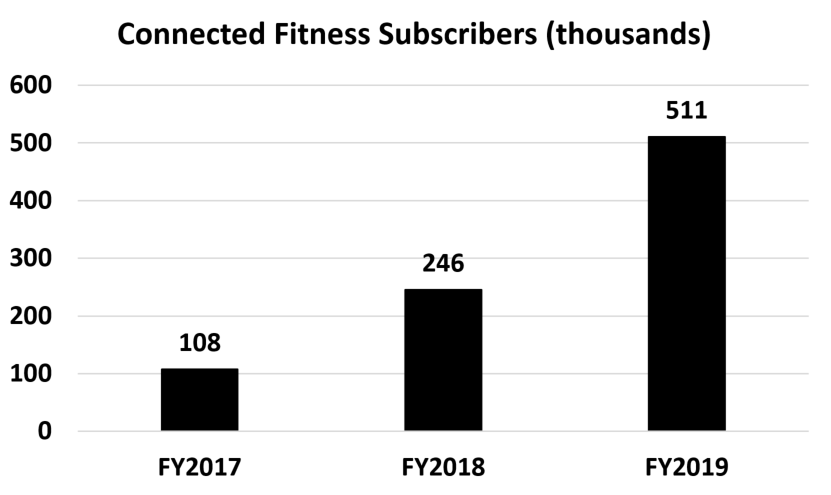Peloton IPO: Everything You Need to Know About This Upcoming Tech IPO
Marijuana Business, Stocks, Finance, & Investing September 5, 2019 MJ Shareholders 0


Should Investors Consider Peloton IPO?
Initial public offerings (IPOs) could be some of the best opportunities for stock market investors. Because an IPO is the first time a company’s shares become available to the general public, high investor interest could translate to a huge surge in stock price.
Looking back, there were plenty of instances when a company’s stock soared double-digits—sometimes even triple-digits—in just a few trading sessions after it went public.
Of course, just like everything in the investment world, high potential returns don’t come risk-free. While we’ve seen some very successful IPOs, there were also instances when a company’s shares tumbled on the first day of trading.
Moreover, even if there’s a soaring IPO stock, it’s not easy for retail investors to buy shares at the IPO price. Often, the price that retail investors face is the price after the stock has already rallied. And because stocks tend to experience pullbacks after a sizable surge, buying an IPO stock after it soared can involve a significant amount of risk.
Now, this is an era when the market is facing a lot of uncertainty. Sluggish economic growth around the world, combined with a trade war between the U.S. and China, have made investors very, very cautious.
In particular, market participants seem to have shied away from volatile sectors (such as tech) recently, and have focused instead on the more recession-proof areas such as consumer staples.
Still, there is one upcoming tech IPO that investors seem to be very enthusiastic about: Peloton Interactive, Inc.
What Is Peloton Interactive, Inc.?
Peloton Interactive, Inc. is an interactive fitness platform company based in New York City. The company currently sells two types of fitness machines: a stationary exercise bicycle starting at $2,245 and a treadmill starting at $4,295.
Note that, while these products are pricey, the company offers financing solutions.
But don’t think for one second that Peloton is just an exercise equipment maker.
The company also offers two types of membership programs. Its “Peloton Membership,” which costs $39.00 a month, allows users to stream Peloton classes on their bikes, treadmills, or through an app. Both the bike and treadmill come equipped with high-definition touch screens.
Meanwhile, the company also offers the less expensive “Digital Membership,” which costs $19.49 per month and delivers classes to users through an app only.
Peloton utilizes a direct-to-consumer multi-channel sales platform, which includes sales specialists, support teams, a high-touch delivery service, and 81 retail showrooms across the U.S., Canada, and the U.K.
Investors interested in the Peloton IPO will be glad to know that, while the company’s products are quite expensive, it has no problem selling them.
According to Peloton’s recent “S-1” filing to the United States Securities and Exchange Commission (SEC), the company has sold approximately 577,000 bikes and treadmills. (Source: “FORM S-1 Registration Statement,” United States Securities and Exchange Commission, August 27, 2019.)
The U.S. has been by far Peloton’s biggest market, with about 564,000 of those bikes and treadmills being sold in the country.
What Is Peloton’s Revenue?
Revenue is probably the key metric that investors researching the Peloton IPO want to know. In the company’s fiscal-year 2019, which ended June 30, 2019, Peloton generated $915.0 million in total revenue.
One of the main reasons why the upcoming Peloton IPO has gotten a lot of investor attention is the growth in the company’s business. Looking back, we see that, in the company’s fiscal-year 2017, its revenue totaled $218.6 million. In fiscal 2018, the number was $435.0 million.
That means, from fiscal 2017 to 2019, Peloton’s total revenue has surged 318.6%.
Now, as we know, Peloton’s products are quite expensive, which means the company is likely making solid margins. And it is. In the fiscal year that ended June 30, 2019, Peloton’s products had a gross margin of 42.9%, while its subscription services had a gross margin of 42.7%.
But it’s not all sunshine and rainbows at this interactive fitness company. For instance, because Peloton’s workouts include music, the company is also a music delivery platform, which means it needs to pay for the rights to the songs it plays for subscribers.
Still, management is confident about controlling the costs associated with music licensing. In the company’s SEC filing, Peloton said,
[U]nlike music streaming services where having an exhaustive music catalog is vital to be able to compete for customers, we have control over what music we select for our classes. As a result, we expect to be able to manage music expense such that, over time, these fees as a percentage of subscription revenue will flatten, or even decrease.
(Source: Ibid.)
How Many Users Does Peloton Have?
Peloton considers itself to be “at the nexus of fitness, technology, and media.” And based on what the company has done, it’s hard to argue with that statement.
Now, because Peloton is associated with tech, investors will be monitoring the size of its user base closely. You see, in this day and age, tech stocks, especially tech stock IPOs, are as much about the user base as they are about revenues and profits.
The idea is, if a company has gotten a large enough user base, it has a good chance of monetizing opportunities. If a company doesn’t have a sizable user base and can’t find ways to acquire more users, its growth potential could be limited.
The good news is, Peloton stands out due to the sheer size of the company’s user base. As of June 30, Peloton had more than 1.4 million account members.
But what about the number of paying members?
Well, at the end of June, the company had 511,202 “Connected Fitness” subscribers and about 103,000 “Peloton Digital” subscribers.
Peloton defines a Connected Fitness subscriber as either a paid subscriber or a “paused” subscriber (Peloton allows Connected Fitness subscribers to pause their subscription for up to three months). The company defines a Peloton Digital subscriber as an individual or household that has a paid Peloton’s digital subscription fee ($19.49 per month).
Peloton noted that the average Connected Fitness subscription was used by approximately two members.
Given the price tag of Peloton’s bikes and treadmills, you might think that the company appeals mainly to wealthy individuals. But that’s not necessarily the case. In Peloton’s “S-1” filing, the company revealed that its fastest-growing consumer demographic segment is actually people under 35 years old and those with household incomes lower than $75,000.” (Source: Ibid.)
In fiscal 2019, the company earned $181.1 million of revenue from subscriptions. That was nearly 20% of Peloton’s total revenue for the fiscal year.
Some of you are probably wondering just how many customers actually stick with paying the monthly fee after they purchase a Connected Fitness product. Well, Peloton gave us an answer in its S-1 filing: among all the Peloton bikes and treadmills ever sold, 92% still had an active Connected Fitness Subscription as of June 30.
What Is Peloton’s Growth Rate?
The reason there’s always a lot of hype around tech stock IPOs is that these tend to be some of the fastest-growing businesses. And the Peloton IPO is no exception.
As we saw earlier, the company more than quadrupled its revenue from fiscal 2017 to fiscal 2019. At the same time, Peloton’s user base also expanded exponentially. From June 30, 2017 to June 30, 2019, the number of Connected Fitness subscribers grew from 107,708 to 511,202, marking a staggering 374.6% increase in just two years. (Source: Ibid.)
(Source: Ibid.)
Is Peloton Interactive, Inc. Profitable?
Peloton is not yet profitable. In its fiscal-year 2019, the company had a net loss of $195.6 million. This compares to its net loss of $47.9 million in its fiscal 2018 and a net loss of $71.1 million in fiscal 2017.
What Is the Peloton Stock Symbol?
According to Peloton’s S-1 filing, the company plans to list its Class A common stock on the Nasdaq Global Select Market under the ticker symbol “PTON.”
How Much Money will Peloton’s IPO Raise?
Peloton Interactive, Inc. plans to raise $500.0 million in its IPO.
How Would Peloton Use the Money?
Peloton intends to use the proceeds from its IPO mainly for working capital and other general corporate purposes. These may include research and development, sales and marketing, general and administrative matters, and capital expenditures.
The company may also use part of the proceeds for acquisitions or investments in technologies, businesses, or solutions that would complement its own business.
What Is Peloton’s IPO Date?
As of this writing, Peloton Interactive, Inc. has not set an IPO date yet.
Analyst Take
In my opinion, the No. 1 reason to check out the Peloton IPO is that the company has built a recurring business.
You see, in the tech world, it’s certainly nice to be able to sell products and services at a high price, but what’s arguably more important is the ability to generate a recurring revenue stream.
When Peloton sells an exercise bike or treadmill, it earns revenue from that sale. But the transaction does not stop there. Once a customer acquires a Peloton Connected Fitness product, chances are they’ll become a paid subscriber.
In other words, Peloton has combined the exercise equipment business (one-time sales) with a gym membership-like business, creating a recurring revenue stream.
At the end of the day, like many growth-stage tech companies, Peloton Interactive, Inc. will probably have to make hefty investments to expand its business. And it remains to be seen when it will turn a profit.
However, given the company’s impressive growth rates, recurring business model, strong retention, and high margin, the Peloton IPO will undoubtedly be one of the most-watched events in the tech world.
MJ Shareholders
MJShareholders.com is the largest dedicated financial network and leading corporate communications firm serving the legal cannabis industry. Our network aims to connect public marijuana companies with these focused cannabis audiences across the US and Canada that are critical for growth: Short and long term cannabis investors Active funding sources Mainstream media Business leaders Cannabis consumers









No comments so far.
Be first to leave comment below.